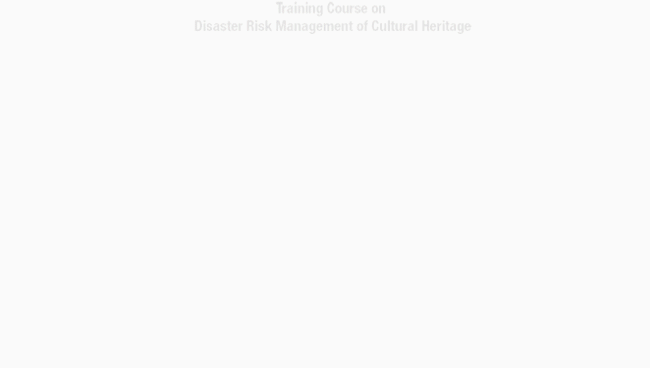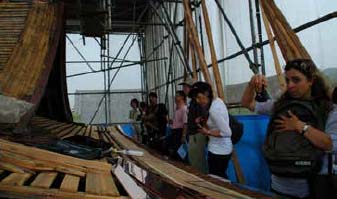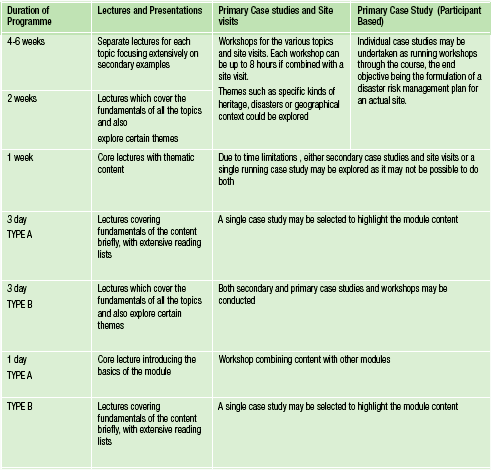


This guide provides different teaching formats: integrating lectures with site studies, workshops and participant presentations using case examples from previously held training programmes organised by R-DMUCH.With each stage of the course, the subject matter may be introduced through one or more introductory lectures, which may also include secondary case examples illustrating certain principles approaches and/or actions. This may be followed by one or more case studies and site visits which form the basis of a participant workshop or activity. Follow up discussions on the case study or workshops are helpful in revisiting the core content delivered through the lectures and illustrated through exemplary practices.


This guide provides different teaching formats: integrating lectures with site studies, workshops and participant presentations using case examples from previously held training programmes organised by R-DMUCH.With each stage of the course, the subject matter may be introduced through one or more introductory lectures, which may also include secondary case examples illustrating certain principles approaches and/or actions. This may be followed by one or more case studies and site visits which form the basis of a participant workshop or activity. Follow up discussions on the case study or workshops are helpful in revisiting the core content delivered through the lectures and illustrated through exemplary practices.
The Core Lectures will present the general principles relating to the disaster risk management process for cultural heritage. These lectures can include various case examples from secondary sources and introduce the potential primary case studies. Further, the resource person may refer to his or her own case examples based on individual experiences.
Thematic Lectures can focus on specific aspects of the disaster risk management process pertaining to the overall thematic focus of the course. These could be supported extensively with secondary case studies along with the primary case study incorporating site visits and workshops. Depending on the length of the course, the proportion of thematic content to core content could vary.
Secondary Case Studies may be used where an aspect of a situation including challenges, opportunities or a successful initiative can be highlighted. Generally, this kind of a study will be brief, concerning itself with a specific aspect of the disaster risk management planning process.
Primary Case Studies (based on site visits) can be highlighted in cases where there is sufficiently detailed information for an in-depth analysis of course content. Also, in some cases, there is more than one aspect, which can be highlighted so that a number of site based exercises together can form part of a primary case study. In order to undertake such a case study, the course instructor must have made an on-site appraisal of the situation and ideally should have good working relationship with the key stakeholders associated with that site such as the site owner or administrator, heritage manager, specialist who has undertaken any task related to disaster risk management of the site. The workshops and lectures should directly link to the primary case study.
Workshops are an important part of the training course and should be linked to the course content. These are primarily aimed at introducing participants to the real issues, challenges, testing tools and methodologies for disaster risk assessment and management of cultural heritage. The workshops consist of classroom or field based exercises to be conducted with simple aids such as work sheets and checklists to be introduced by the resource persons. The resource person or coordinator should be familiar with the site on which the workshop is based and have knowledge of its constraints, context and values. Ideally they should be, or have been, directly involved in the site management in some capacity.
Participant Case Study Project aims at preparing an outline of disaster risk management plan to be prepared by each participant for a particular cultural heritage site from his or her home country. This case study project should be decided by the participant before attending the course and all the relevant information including data and maps on the site and its disaster profile should be collected in advance by the participant before attending the course. In fact for the training courses organised by R-DMUCH, the selection of case study project is made by the candidate at the time of application for the course and is one of the important criterion for the selection of participant. The participants can develop the case study project through the duration of the course. In fact specific time slots should be kept for this purpose under each module so that lessons learned in that module can be applied by the participants to their case study projects. The team of resource persons can mentor the participants for developing case study projects, which can be presented by each participant at the end of the course for evaluation by an expert jury. Preparation of case study projects is given high priority in the international training course organised by R-DMUCH and a mid-term review is also organised at the end of first week. Having a tangible goal for the end of the course is useful for participants.

